Scientific Clarification
The following are the crop details for Cashew Nuts
- Scientific name: Cucurbita spp. (Cucurbita maxima, Cucurbita moschata etc.)
- Local names: Budho (Luo), Malenge (Kiwahili), Lisiebebe (Luhya), Marenge (Kikuyu), Risoa (Kisii), Ulenge (Kamba)
- Order: Cucurbitales
- Family: Cucurbitaceae
- Genus: Cucurbita spp.

Pumpkin fruit

Pumpkin

Flower

Pumpkin flowering

Pumpkin plant

Pumpkin leaves
General Information
Pumpkin is the name given to a group of plant species in the genus Cucurbita, including Cucurbita pepo, Cucurbita mixta, Cucurbita maxima, and Cucurbita moschata. It is grown primarily as a vegetable or ornamental plant.
Pumpkins have long-running, bristled stems, large deeply-lobed leaves often containing white blotches, and yellow or orange flowers separated into male and female types on the same plant. The fruit is variable in shape and color but is often white, cream, or green, containing about 70% flesh and several large white seeds.
Pumpkin plants are short-lived annual or perennial vines with branching tendrils and broad lobed leaves. The plant produces large yellow or orange flowers and a pepo fruit (berry with a thick rind) known as a pumpkin. The fruit can range greatly in size, from miniature pumpkins weighing a few ounces to giant pumpkins which can reach over 75 lbs (34 kg). The skin of the pumpkin is usually ribbed and is usually orange in color although some varieties are green, grey, yellow, or red. Pumpkin plants are usually grown as annuals, surviving one growing season and the vines are capable of reaching 15 m (50 ft) in length if vines are allowed to root. Pumpkin may also be referred to as squash or marrow and is believed to have originated in Mexico and South America.
Varieties of butternut available in Kenya
"Butternut 401". It has resistance to powdery mildew
"Bugle". It has resistance to powdery mildew.
"Early Butternut F1". It has resistance to powdery mildew.
"Ultra F1". It has resistance to Fusarium wilt and powdery mildew.
"Waltham". It has resistance to powdery mildew.
Climate Conditions, Soil, and Water Management
Pumpkins and squashes (various Cucurbita spp.) are grown in the tropics from the lowlands up to 2500 m altitude. They are warm-season crops adapted to monthly mean temperatures of 18-27°C. C. maxima is the most tolerant of low temperatures, C. moschata and C. argyrosperma the least, with C. pepo intermediate. C. maxima and C. pepo have long been cultivated in temperate regions. Butternut appreciates part shade in very hot conditions, such as can be obtained when intercropped with other crops or grown under fruit trees.
Pumpkins and squashes respond very well to medium to heavy applications of compost or well-decomposed manure. They can be cultivated on almost any fertile, well-drained soil with a neutral or slight acid reaction (pH 5.5 to 7). They are drought-tolerant, require relatively little water, and are sensitive to waterlogging. Excessive humidity is harmful because of the development of leaf diseases, so none of the species do well in the humid tropics.
Uses
Pumpkin flesh, leaves, and flowers can be cooked and eaten in a variety of dishes. The seeds are also edible and are commonly roasted and eaten as a snack.
Ornamental gourds are cultivars of C. pepo with small, bitter, and inedible fruits in many shapes, sizes, and colors.
The pumpkin has been used as a medicine in Central and North America. It is a gentle and safe remedy for several complaints. The seeds are widely used as an anthelmintic. The complete seed, together with the husk, is used to remove tapeworms.
The fruit and seed decoctions have been reported to be used as diuretics and to reduce fevers, and are used for curing indigestion. The pulp is applied to burns and scalds, inflammation, abscesses, and boils. It is also used in the treatment of migraine and neuralgia.
Planting Procedure
Pumpkins and squashes are grown from seed. Seeds may be sown in containers and transplanted to the field when they are 10 cm high. Direct seeding of 2 to 3 seeds per hill is commonly practiced. Trailing types are planted at distances of 2-3 m either way; the seed requirement is 2 to 3 kg/ha. The bushy types (mainly C. pepo) are planted closer, for example, plants spaced 60 to 120 cm in rows 1 to 1.5 m apart; the seed requirement is 3 kg/ha for pumpkin and 7 kg/ha for summer squash (C. pepo). Do not use seeds from plants where edible pumpkins and ornamental gourds are grown close together. Offspring will be bitter or even inedible.
Husbandry
Sole cropping is sometimes used for commercial production. Pumpkins and squashes are also planted in home gardens or mixed with field crops such as maize. Cultural practices to improve growth and development include the removal of growing tips (in trailing varieties) to check growth, and the bagging of fruits in paper to protect against fruit flies and other pests. Fruit sets may be stimulated by manual pollination. The fruit may rot when in contact with moist soil, so often cut grass or leaves are placed beneath the fruit.
Harvesting
Winter squashes and pumpkins are picked when mature in a once-over harvest or in several rounds, about 90 to 120 days after planting depending on the variety. Pumpkins are considered to be among the most efficient vegetable crops when evaluated on nutritional yield land area and labor needed. Indicative figures for the seed yield of C. pepo are 400 to 1500 kg/ha. A valuable source of oil and protein is thus neglected if the seeds are left unutilized. In seed production, isolation between fields of different Cucurbita species is recommended, not only for the reason of purity but also for obtaining maximum yields (pollen of other species may cause reduced fruit set).
References
Anderson, C. R. Pumpkins. University of Arkansas Division of Agriculture. Available at: http://www.uaex.edu/publications/pdf/FSA-6074.pdf. [Accessed 02 April 15].
Free to access.
Bratsch, A. Pumpkins. Virginia Cooperative Extension. Available at: http://pubs.ext.vt.edu/438/438-100/438-100_pdf.pdf. [Accessed 02 April 15].
Free to access.
Strang, J. (2012). Pumpkins. University of Kentucky Cooperative Extension. Available at: http://www.uky.edu/Ag/NewCrops/introsheets/pumpkinintro.pdf. [Accessed 02 April 15].
Free to access.
Zitter, T. A., Hopkins, D. L. & Thomas, C. E. (1996). Compendium of Cucurbit diseases. American Phytopathological Society Press. Available at: http://www.apsnet.org/apsstore/shopapspress/Pages/42074.aspx.
Available for purchase from APS Press.
Common Pests and Diseases
Diseases
Category : Fungal
Alternaria leaf blight
Alternaria cucumerina
Symptoms
Small, yellow-brown spots with a yellow or green halo which first appear on the oldest leaves; as the disease progresses, lesions expand and becone large necrotic patches, often with concentric patternation; lesions coalesce, leaves begin to curl and eventually die
Cause
Fungus
Comments
Management
Cucurbits should be rotated with another crop every 2 years to reduce levels of inoculum; crop debris should be removed from the field as quickly as possible after harvest or plowed deeply into the soil; applications of appropriate protective fungicides can help to slow the development of the disease; water plants from the base rather than from above to reduce periods of leaf wetness which are conducive to the development and spread of disease
Alternaria leaf spot
Alternaria alternata
Symptoms
Initial symptoms appear as necrotic flecks on leaves with chlorotic halos; as the disease progresses, the flecks grow into spots which may join together into large, roughly circular lesions; if infestation is severe, leaves begin to turn yellow and die
Cause
Fungus
Comments
Management
Crops debris should be removed from the field or plowed deeply into the soil after harvest; applications of appropriate protective fungicides can hep reduce the incidence of the disease
Cercospora leaf spot
Cercospora citrullina
Symptoms
Initial symptoms of disease occur on older leaves as small spots with light to tan brown centers; as the disease progresses, the lesions enlarge to cover large areas of the leaf surface; lesions may have a dark border and be surrounded by a chlorotic area; the centers of the lesions may become brittle and crack
Cause
Fungus
Comments
Management
Any diseased plants should be removed and destroyed to prevent further spread; crop debris should be removed after harvest or plowed deeply into the soil to reduce inoculum
Downy mildew
Pseudoperonospora cubensis

Downy mildew on pumpkin leaf

Downy mildew symptoms

Downy mildew symptoms
Symptoms
Dead or dying leaves; yellow to brown lesions on the upper side of leaves; purple growth developing on the underside of leaves
Cause
Fungus
Comments
Management
Do not overcrowd plants; avoid overhead irrigation, water plants from base; apply appropriate fungicide
Fusarium crown and foot rot
Fusarium solani
Symptoms
Wilting of leaves progresses to wilting of entire plant and plant dies within a few days; distinctive necrotic rot of crown and upper taproot when plant is uprooted; plant breaks easily below soil line
Cause
Fungus
Comments
Management
Plant fungicide treated seed; rotate crops on 4 year rotation
Gummy stem blight
Didymella bryoniae
Symptoms
Brown or tan spots of various sizes on leaves; leaves covered with lesions; stems splitting and forming cankers; wounds exude a brown, gummy substance; wilting vines; death of stems
Cause
Fungus
Comments
Management
Use disease free seed; treat seeds prior to planting; rotate crops every 2 years
Powdery mildew
Erysiphe spp.
Sphaerotheca spp.

Powdery mildew on pumpkin leaves

Symptoms of powdery mildew on pumpkin vines

Powdery mildew on pumpkin leaf
Symptoms
White powdery mold on stems, leaves and petioles; stems may be weakened
Cause
Fungi
Comments
Management
Plant in sites with good air circulation and sun exposure; do not overcrowd plants; sanitize equipment regularly
Septoria leaf spot
Septoria cucurbitacearum
Symptoms
Initial symptoms of disease are small dark water-soaked spots on the leaves which turn beige to white in dry conditions; lesions develop thin brown borders and the centers may become brittle and crack; small white spots may erupt on the surface of infected butternut and acorn squash and pumpkin fruit
Cause
Fungus
Comments
Management
Scout plants during cool wet conditions for any sign of spots; early application of an appropriate protective fungicide can help limit the development of the disease if spots are found, cucurbits should be rotated with other crops every 2 years to prevent the build-up of inoculum; crop debris should be removed and destroyed after harvest
Southern blight
Sclerotium rolfsii

Southern blight symptoms on pumpkin fruit

Southern blight symptoms on pumpkin fruit

Southern blight symptoms on pumpkin fruit

Southern blight symptoms on pumpkin fruit

Southern blight symptoms on pumpkin fruit
Symptoms
Sudden wilting of leaves; yellowing foliage; browning stem above and below soil; browning branches; stem may be covered with fan-like mycelial mat; rot on fruit that begins on side in contact with soil
Cause
Fungus
Comments
Management
Remove infected plants; avoid overcrowding plants to promote air circulation; rotate crops with less susceptible plants; plow crop debris deep into soil; provided a barrier to infection by wrapping lower stems of plant with aluminum foil covering below ground portion of stem and 2-3 in above soil line
Verticillium wilt
Verticillium dahliae
Symptoms
Symptoms generally appear after fruit set; chlorotic leaves which develop necrotic areas; leaves collapsing; symptoms only on one side of vine; discoloration of vascular tissue in roots
Cause
Fungus
Comments
Management
Do not plant in areas where other susceptible crops have been grown previously; delay planting until temperatures are warmer
Category : Bacterial
Angular leaf spot
Pseudomonas syringae
Symptoms
Small water-soaked lesions on leaves which expand between leaf veins and become angular in shape; in humid conditions, lesions exude a milky substance which dries to form a white crust on or beside lesions; as the disease progresses, lesions turn tan and may have yellow/green edges; the centers of the lesions dry and may drop out leaving a hole in the leaf
Cause
Bacterium
Comments
Management
Use disease-free seed; do not grow plants in field where cucurbits have been grown in the previous 2 years; protective copper spray may help reduce incidence of disease in warm, humid climates; plant resistant varieties
Bacterial leaf spot
Xanthomonas campestris
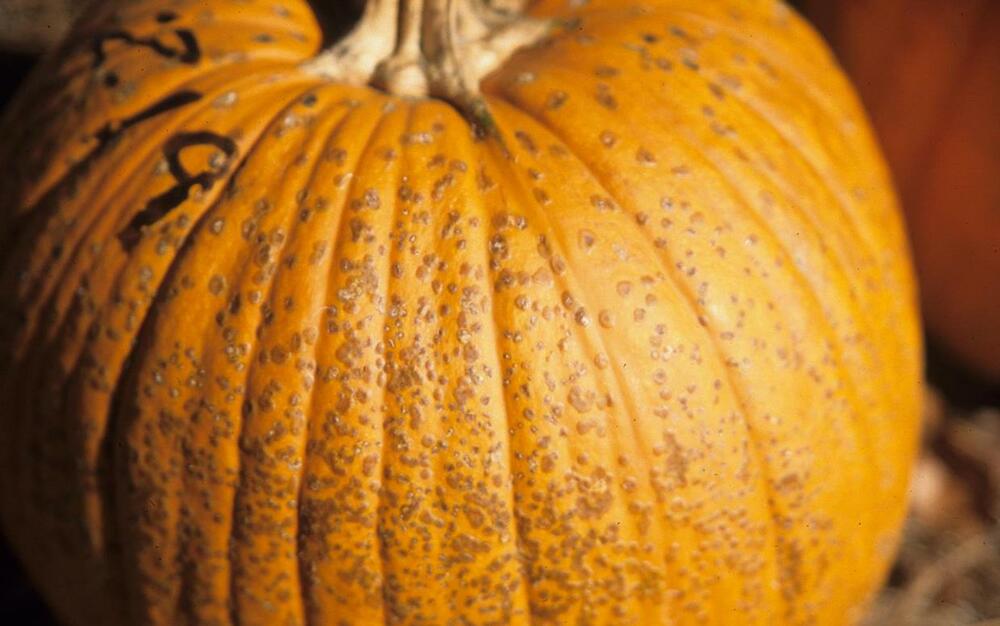
Symptoms of bacterial spot on pumpkin fruit
Symptoms
Dark, angular lesions on leaves; leaf lesions may coalesce and cause severely blighted foliage; water-soaked lesions which enlarge and develop into tan scabs, or blisters, on the fruit; blisters eventually flatten as they reach their full size
Cause
Bacterium
Comments
Management
Avoid overhead irrigation; rotate crops away from cucurbit species to prevent disease building up; use new seed each planting as saved seed is more likely to carry bacteria; apply appropriate protective fungicides; copper containing fungicides generally provide good control
Bacterial wilt
Erwinia tracheiphila
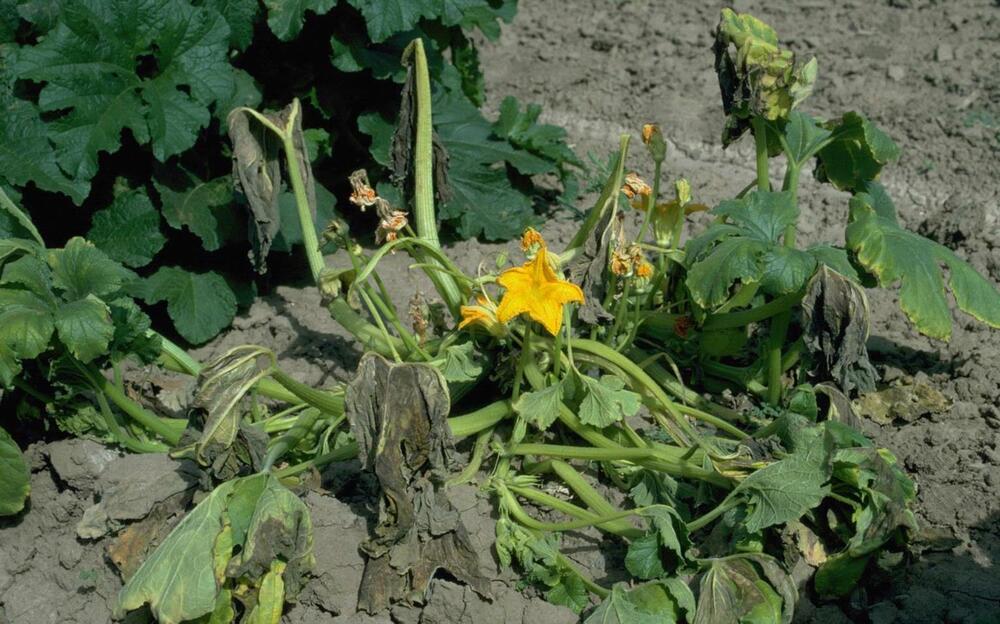
Symptoms of bacterial wilt (image of closely related summer squash)
Symptoms
Wilting of individual runners or entire plant; leaves and stems of affected parts turn dark green; wilting is irreversible; affected parts turn necrotic
Cause
Bacterium
Comments
Management
Control cucumber beetle populations on plants; hand pick adult beetles and destroy; soil and foliar application of appropriate insecticides may help to control populations
Category : Other
Aster yellows
Aster yellows phytoplasma
Symptoms
Foliage turning yellow; secondary shoots begin growing prolifically; stems take on a rigid, upright growth habit; leaves are often small in size and distorted, may appear thickened; flowers are often disfigured and possess conspicuous leafy bracts; fruits are small and pale in color
Cause
Phytoplasma
Comments
Management
Remove any infected plants from the field to reduce spread; control weeds in and around the field that may act as a reservoir for the phytoplasma; protect plants from leaf hopper vectors with row covers
Category : Viral
Cucumber mosaic
Cucumber mosaic virus (CMV)
Symptoms
Plants are severely stunted; foliage is covered in distinctive yellow mosaic; leaves of plant curl downwards and leaf size is smaller than normal; flowers on infected plants may be deformed with green petals; fruits become distorted and are small in size; fruit is often discolored
Cause
Virus
Comments
Management
Control of the virus is largely dependant on the control of the aphid vectors; reflective mulches can deter aphid feeding; aphid outbreaks can be treated with mineral oils or insecticidal soap applications; some resistant varieties are available
Squash mosaic
Squash mosaic virus (SqMV)
Symptoms
Symptoms vary with variety being grown but plants can show symptoms which include include green veinbanding, mottled leaves, blisters, ring spots or potruding veins at leaf margins; some squash varieties may develop leaf enations; infected plants are often stunted and fruits may be malformed with mottled skin
Cause
Virus
Comments
Management
Use only certified disease-free seed
Watermelon mosaic
Watermelon mosaic virus (WMV)
Symptoms
Symptoms vary widely depending on species, cultivar, virus strain and environmental conditions; symptoms on leaves may include green mosaic patternation, green vein-banding, chlorotic rings and disfigured leaves
Cause
Virus
Comments
Management
Treatments that control populations of aphid vectors can also reduce the incidence of the virus; spraying plants with mineral oils or insecticidal soaps can help to reduce aphid numbers
Zucchini yellow mosaic
Zucchini yellow mosaic virus (ZYMV)
Symptoms
Infected plants are severely stunted and leaves can exhibit a variety of symptoms including yellow mosaic patternation, severe deformation, blistering, reduced size and necrosis; fruits are deformed
Cause
Virus
Comments
Management
Use of resistant varieties, where available, is usually the most effective method of controlling the virus; control of aphid populations on the plants can be achieved through the use of mineral oils and insecticidal soaps but is rarely effective at controlling the virus
Category : Oomycete
Phytophthora blight
Phytophthora capsici
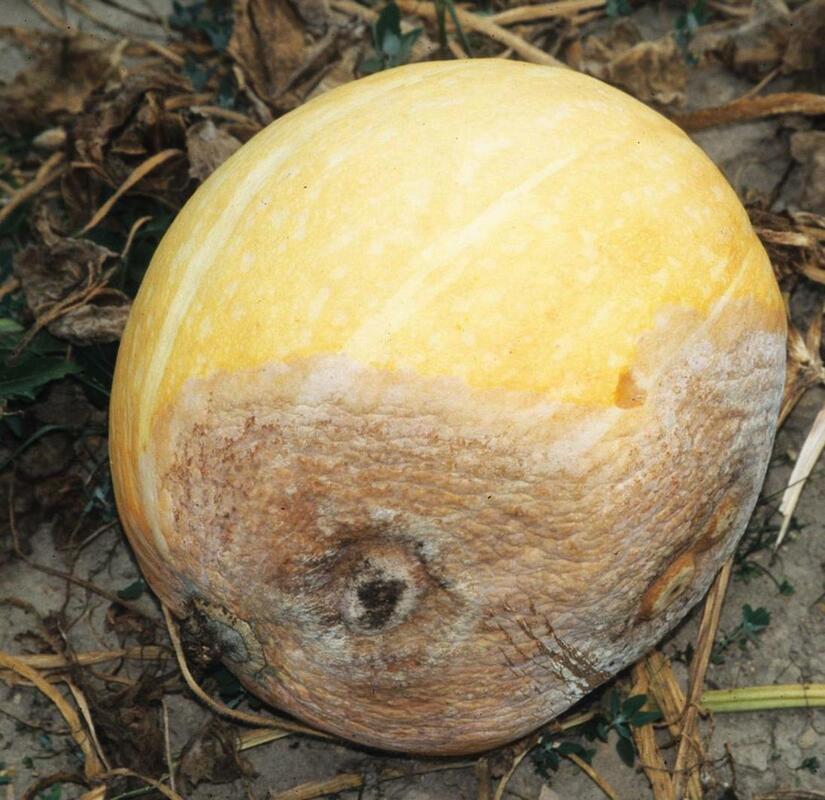
Symptoms of Phytophthora blight on pumpkin fruit
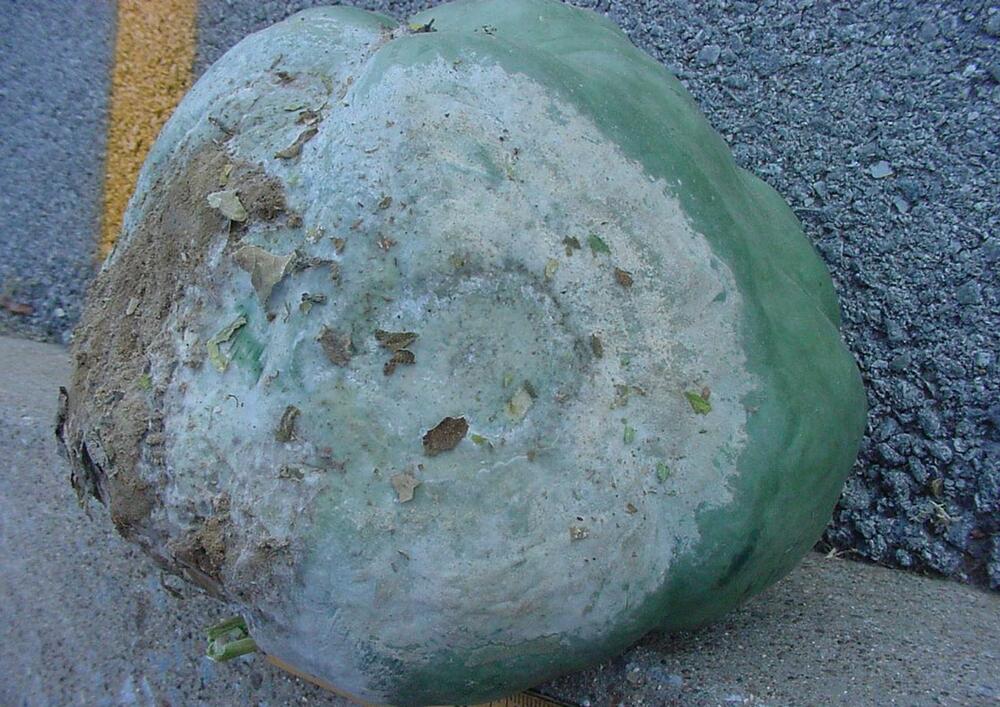
Symptoms of Phytophthora blight on pumpkin fruit
Symptoms
Sudden and permanent wilting of plant; leaves do not change color; plant death within a few days; roots and stem close to soil line discolored light to dark brown; plant easily removed from soil; fluffy mold growing on soft rotting fruit
Cause
Oomycete
Comments
Management
Efficient management of water to avoid saturated soil; avoid long periods of irrigation
Pests
Category : Insects
Aphids (Green peach aphid, Melon aphid)
Myzus persicae
Aphis gossypii
Symptoms
Small soft bodied insects on underside of leaves and/or stems of plant; usually green or yellow in color, but may be pink, brown, red or black depending on species and host plant; if aphid infestation is heavy it may cause leaves to yellow and/or distorted, necrotic spots on leaves and/or stunted shoots; aphids secrete a sticky, sugary substance called honeydew which encourages the growth of sooty mold on the plants
Cause
Insect
Comments
Management
If aphid population is limited to just a few leaves or shoots then the infestation can be pruned out to provide control; check transplants for aphids before planting; use tolerant varieties if available; reflective mulches such as silver colored plastic can deter aphids from feeding on plants; sturdy plants can be sprayed with a strong jet of water to knock aphids from leaves; insecticides are generally only required to treat aphids if the infestation is very high - plants generally tolerate low and medium level infestation; insecticidal soaps or oils such as neem or canola oil are usually the best method of control; always check the labels of the products for specific usage guidelines prior to use
Armyworms (Beet armyworm, Western striped armyworm, etc.)
Spodoptera exigua
Spodoptera praefica

Beet armyworm larva
Symptoms
Singular, or closely grouped circular to irregularly shaped holes in foliage; heavy feeding by young larvae leads to skeletonized leaves; shallow, dry wounds on fruit; egg clusters of 50-150 eggs may be present on the leaves; egg clusters are covered in a whitish scale which gives the cluster a cottony or fuzzy appearance; young larvae are pale green to yellow in color while older larvae are generally darker green with a dark and light line running along the side of their body and a pink or yellow underside
Cause
Insect
Comments
Management
Organic methods of controlling armyworms include biological control by natural enemies which parasitize the larvae and the application of Bacillus thuringiensis; there are chemicals available for commercial control but many that are available for the home garden do not provide adequate control of the larvae
Cabbage looper
Trichoplusia ni

Cabbage looper
Symptoms
Large or small holes in leaves; damage often extensive; caterpillars are pale green with a white lines running down either side of their body; caterpillars are easily distinguished by the way they arch their body when moving; eggs are laid singly, usually on the lower leaf surface close to the leaf margin, and are white or pale green in color
Cause
Insect
Comments
Management
Looper populations are usually held in check by natural enemies; if they do become problematic larvae can be hand-picked from the plants; an organically acceptable control method is the application of Bacillus thuringiensis which effectively kills younger larvae; chemical sprays may damage populations of natural enemies and should and should be selected carefully
Cucumber beetles (Western striped cucumber beetle, Western spotted cucumber beetle, Banded cucumber beetle)
Acalymma vittata
Diabrotica undecimpunctata
Diabrotica balteata

Pumpkin plant infested with cucumber beetles

Western spotted cucumber beetle

Pumpkin plant infested with cucumber beetles

Western striped cucumber beetle

Banded cucumber beetle
Symptoms
Stunted seedling; damaged leaves, stems and/or petioles; reduced plant stand; plants may exhibit symptoms of bacterial wilt; scars on fruit caused by beetle feeding damage; adult beetles are brightly colored with either a green-yellow background and black spots or alternating black and yellow stripes
Cause
Insect
Comments
Management
Monitor new planting regularly for signs of beetle; floating row covers can be used to protect the plants from damage but will need to be removed at bloom to allow bees to pollinate plants; applications of kaolin clay can be effective for management of small beetle populations; application of appropriate insecticides may be necessary
Cutworms
Cutworms
Agrotis spp.
Peridroma saucia
Nephelodes minians
and others

Cutworms will curl up into a characteristic C shape when disturbed

Cutworm larva severing plant stem
Symptoms
Stems of young transplants or seedlings may be severed at soil line; if infection occurs later, irregular holes are eaten into the surface of fruits; larvae causing the damage are usually active at night and hide during the day in the soil at the base of the plants or in plant debris of toppled plant; larvae are 2.5–5.0 cm (1–2 in) in length; larvae may exhibit a variety of patterns and coloration but will usually curl up into a C-shape when disturbed
Cause
Insects
Comments
Management
Remove all plant residue from soil after harvest or at least two weeks before planting, this is especially important if the previous crop was another host such as alfalfa, beans or a leguminous cover crop; plastic or foil collars fitted around plant stems to cover the bottom 3 inches above the soil line and extending a couple of inches into the soil can prevent larvae severing plants; hand-pick larvae after dark; spread diatomaceous earth around the base of the plants (this creates a sharp barrier that will cut the insects if they try and crawl over it); apply appropriate insecticides to infested areas of garden or field if not growing organically
Flea beetles
Epitrix spp.
Systena spp
Symptoms
Small holes or pits in leaves that give the foliage a characteristic “shothole” appearance; young plants and seedlings are particularly susceptible; plant growth may be reduced; if damage is severe the plant may be killed; the pest responsible for the damage is a small (1.5–3.0 mm) dark colored beetle which jumps when disturbed; the beetles are often shiny in appearance
Cause
Insects
Comments
Management
In areas where flea beetles are a problem, floating row covers may have to be used prior to the emergence of the beetles to provide a physical barrier to protect young plants; plant seeds early to allow establishment before the beetles become a problem - mature plants are less susceptible to damage; trap crops may provide a measure of control - cruciferous plants are best; application of a thick layer of mulch may help prevent beetles reaching surface; application on diamotecoeus earth or oils such as neem oil are effective control methods for organic growers; application of insecticides containing carbaryl, spinosad, bifenthrin and permethrin can provide adequate control of beetles for up to a week but will need reapplied
Squash bug
Anasa tristis

Squash bug nymphs

Pumpkin leaves damaged by squash bugs

Close-up of squash bugs feeding on pumpkin fruit

Squash bug infestation on pumpkin

Pumpkin leaves damaged by squash bugs
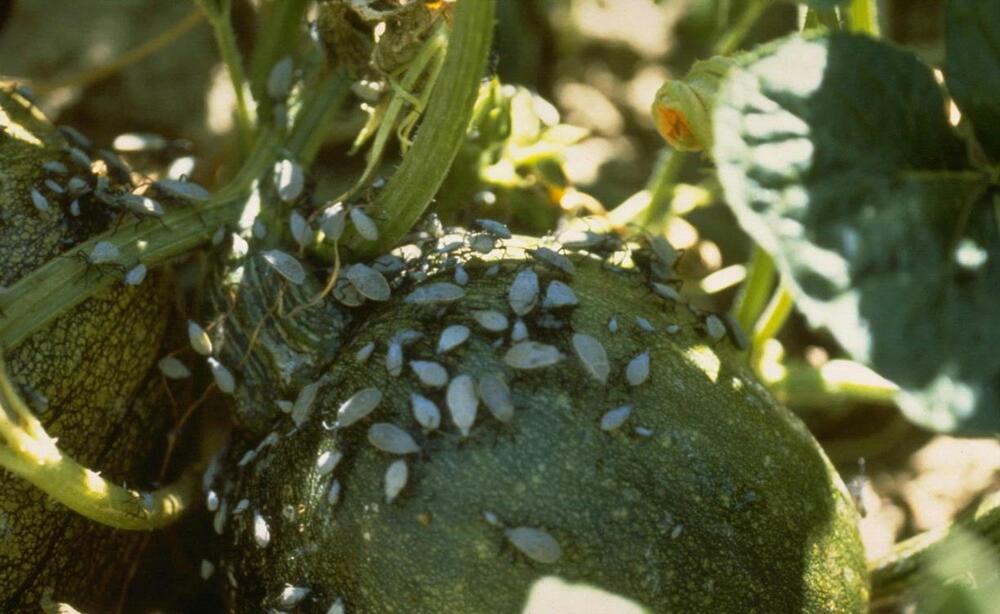
Squash bugs feeding on pumpkin leaves and fruit
Symptoms
Speckled leaves which turn yellow and brown; wilting plants; dieback of runners; blemished fruit; fruit death; adult squash bugs are often misidentified as stink bugs; they are grey-black in color with orange and black stripes on the edges of their abdomen; nymphs are greenish gray in color and often covered in white powder; female squash bugs lay conspicuous copper colored eggs on the undersides of the leaves
Cause
Insect
Comments
Management
Destroy all crops residue as soon as possible after harvest or on plant death; apply row covers at planting to protect plants;organically acceptable control methods include applications of insecticidal soaps and oils
Squash vine borer
Melittia cucurbitae
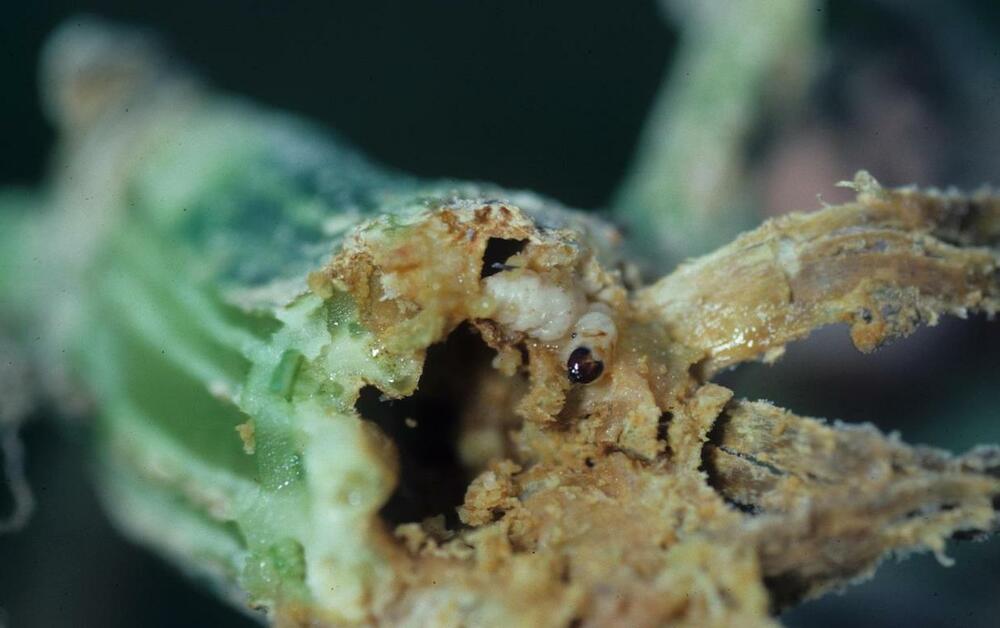
Squash vine borer damaging vine
Symptoms
Wilting plants; holes in vines or at base of petioles; green frass (insect excrement) visible around holes
Cause
Insect
Comments
Management
Apply appropriate insecticide if eggs are found on leaves; plow plants into soil after harvest
Thrips (Western flower thrips)
Frankliniella occidentalis

Western flower thrips
Symptoms
If population is high leaves may be distorted; leaves are covered in coarse stippling and may appear silvery; leaves speckled with black feces; insect is small (1.5 mm) and slender and best viewed using a hand lens; adult thrips are pale yellow to light brown and the nymphs are smaller and lighter in color
Cause
Insect
Comments
Management
Avoid planting next to onions, garlic or cereals where very large numbers of thrips can build up; use reflective mulches early in growing season to deter thrips; apply appropriate insecticide if thrips become problematic






































